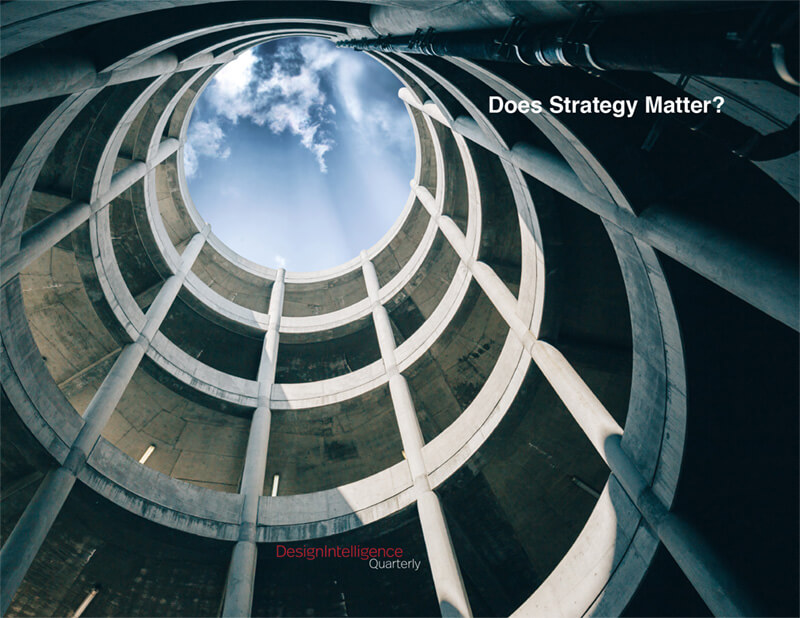Does Strategy Matter?
by Scott Simpson
FAIA and Senior Fellow,
Design Futures Council
A perspective on post-Covid recovery with actionable steps for firm leaders.
In February of 2020, the economic outlook had never looked brighter. The stock market reached historic highs and both interest rates and unemployment were at record lows. It was clear sailing ahead with no clouds on the horizon. Just a few weeks later the market was in freefall, plummeting by more than 30%. Trillions of dollars in asset value were wiped out along with tens of millions of jobs. Over 50% of the world GDP was in lockdown. Nobody saw it coming.
Every competent business leader plans for the unexpected in both good times and bad. But the breathtaking speed of the crisis, compounded by its breadth and depth, have overwhelmed us all. It seems everything has come untethered; there are no reliable benchmarks by which to navigate. All predictions about the economy in the coming year need to be re-thought, and those handsomely bound strategic plans can be consigned to the shredder.
Design firms will be particularly hard hit. In many cities, construction has been shut down entirely. Clients are in survival mode and scrambling to find ways to stay alive; they are not in the mood to make long-term capital investments. Some market sectors, such as healthcare, are simply overwhelmed, while others, like education, face a very uncertain future. By necessity, schools have converted to on-line learning, and those which must rely on tuition to pay the bills may not be able to re-open at all come September, if ever. Commercial clients see empty stores and offices, and residential developers must contend with the prospect of tenants who simply cannot pay their rent. For design firms, backlog is quickly evaporating, accounts receivable are lagging, and prospects for new projects are dim at best. Now what?

Think Positive
First, the good news: in these uncertain times, there is one certainty: things will eventually get better. While the pandemic has hit like a tornado, severely damaging everything in its path, there is still much left intact. The economy may be in a deep freeze, but the basic infrastructure remains in place, and certain elements such as financial services continue to operate well. Thanks to the vibrant and creative biotech industry, sooner or later therapeutics and a vaccine will be found to effectively combat the virus. In the meantime, as with all crises, this one has much to teach us if we are willing to pay attention.
This is when design thinking is needed most. Schools may be closed, but we are getting a crash course in the benefits of e-commerce. Business models are being entirely upended as supply chains get re-jiggered and working from home becomes the default option. When the dust settles, we will quickly discover that many of these changes born out of necessity have become permanently baked into the system. Sometimes it’s hard to tell disaster from opportunity, but the bigger and more disruptive the changes are, the more interesting the options.
Strategic Optimism
Design thinkers are optimists by nature; they believe solutions exist if we are willing to search for them. As Daniel Pink writes in his book A Whole New Mind, “The future belongs to a very different kind of person, with a very different kind of mind—creators and emphasizers, pattern recognizers, designers, storytellers, big picture thinkers and meaning makers. These people will now reap society’s biggest rewards and share its greatest joys.” This perspective provides the framework for how we can move forward.
Two basic perspectives are required for effective planning: what to do and what not to do. Both are equally essential. There are also two kinds of priorities: what’s most important, and what needs to be done first. (Note: they are rarely the same things.) As we make the pivot from the pre-pandemic mindset to the post-Covid-19 world, it will be difficult but essential to discard the baggage of prior assumptions which simply no longer apply. That’s excess baggage. We’ll have to accept the fact that some businesses will fail outright, and others will need to make radical changes in order to survive. The trick is to understand what remains relevant and should be retained or re-engineered, and what must be discarded and replaced. These points of view can be applied to internal operations as well as externally, to the world of clients. Clients are, after all, the reason design firms exist in the first place.
Silver Linings and Unintended Consequences
For starters, be on the lookout for both silver linings and unintended consequences. Silver linings can be hard to spot because they are often counter-intuitive. What looks like disaster at first glance may in hindsight turn out to have been a stroke of good luck. When things can’t get done by conventional means, other methods will inevitably be devised. Often, the new workarounds will reveal just how inefficient, or even unnecessary, conventional practices were in the first place. The best way to deal with ineffective things is not to do them at all. As for unintended consequences, they will always surface sooner or later, both for good and ill, and as with silver linings, they are usually well camouflaged. Sometimes what seems like a good idea at first turns out to be self-destructive in the long run.
This is not a one-size-fits-all pandemic. Some sectors of the economy, like travel and hospitality, have been especially hard hit, while others, like e-commerce and logistics, are flourishing. The impact has been dramatically different based on a number of factors. Densely populated urban centers are the hardest hit, of course, but not all equally so. It follows that the path forward is likely to be very different in different locations. This requires organizations to be alert and nimble.
Implications and Actions
The same will be true for design firms. For many, business has ground to a halt, but others are reporting little if any impact, at least so far. Obviously, size, location, market focus, current backlog, and client mix are key variables. Those with a higher proportion of public vs. private sector work will be better insulated. Also, some firms are better prepared than others for the working from home scenario, which is now standard operating procedure. That change alone has interesting long term implications, not the least of which is how much office space is really needed to function effectively.

Firm leaders need to attend to the home fires first by doing an objective review of the status of all projects under contract. Which ones have been delayed or cancelled, and which can still proceed? What is the current backlog and the firm’s cash position? Assuming no new work will come in over the next several months, how long can the firm survive given the burn rate? The answers to these questions will inevitably lead to the question of staffing. Some will need to be laid off, some furloughed, and others may still be viable depending upon how long the downturn lasts. Selective pay cuts, always a last resort, may be necessary. The prospect of cutting staff or compensation is the most painful decision that firm leaders will need to face. However, if the appropriate action is not taken, it only serves to hasten the demise of the enterprise.
While conducting the internal assessment, it’s also essential to get in touch with clients. All of them are hurting, but each in a different way. More than ever, they need help, and design thinking can provide it. One of the silver linings is that clients have more time to chat. Lunches, dinners, presentations and conferences are no longer viable, but you can still communicate effectively via phone, e-mail, and videoconferencing. Now is the time to get inside your clients’ heads to understand what they are thinking and what they need most. (Note: this is not about seeking new business, but rather developing deep understanding and empathy so that you will be better able to help when the storm passes.)
It helps to remember that in times like these, there is no such thing as “normal” or “fair”. While there have been pandemics before (the Spanish flu of 1918, polio in the 50’s, and AIDs) each
one was unique. If there is any good news, judging from the data available so far, COVID-19 is far from the worst, though it has yet to run its course and reliable data is hard to come by. The economic impact is still unknown; it will be more severe in some sectors, but less so in others.
Once you’ve got a firm grasp on what’s happening inside your firm as well as in your clients’ organizations, then apply design thinking to your own business model. Don’t assume the task is merely to survive the pandemic and get back to normal; rather, the goal is to emerge as a better, stronger, more proficient firm. In this regard it helps to recall the words of Wayne Gretzky, the world champion hockey player: don’t skate to where the puck is today, skate to where the puck will be next. What does a post-Covid-19 world look like? What factors are likely to be the same, and what will be different? What changes are needed so that when the pandemic begins to subside, which it inevitably will, your firm will be better off? The key to is to imagine the best possible outcome and then work backwards from that.
Above all, maintain strategic optimism. We’ve seen this movie before. During the great recession of 2008—2010, many design firms were severely damaged or wiped out entirely. Unemployment, especially among young designers, exceeded 30%. Yet within a few years, things had rebounded and the stage was set for the biggest economic expansion in history. Things did not “return to normal”—they actually got much better. The same thing will happen when the current pandemic subsides. Strategic planning will provide the roadmap. Design thinking will make it happen.
The recovery is likely to be a bumpy road, for sure, but it is a road we all must travel.
Scott Simpson, FAIA is a Senior Fellow in the Design Futures Council and a frequent contributor to DesignIntelligence.


